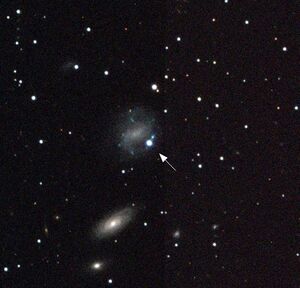Astronomy:SN 1998bw
 | |
| Spectral class | Type Ic |
|---|---|
| Date | 26 April 1998 |
| Constellation | Telescopium |
| Right ascension | 19h 35m 03.30s |
| Declination | −52° 50′ 45.9″ |
| Galactic coordinates | 344.99°, −27.72° |
| Host | ESO 184-G82 |
SN 1998bw was a rare broad-lined Type Ic[1] gamma ray burst supernova detected on 26 April 1998 in the ESO 184-G82 spiral galaxy, which some astronomers believe may be an example of a collapsar (hypernova).[2] The hypernova has been linked to GRB 980425, which was detected on 25 April 1998, the first time a gamma-ray burst has been linked to a supernova.[3] The hypernova is approximately 140 million light years away, very close for a gamma ray burst source.[4]
The region of the galaxy where the supernova occurred hosts stars 5-8 million years old and is relatively free from dust. A nearby region hosts multiple Wolf-Rayet stars less than 3 million years old, but it is unlikely that the supernova progenitor could be a runaway from that region. The implication is that the progenitor was a star originally 25-40 M☉ if it exploded as a single star at the end of its life.[5]
References
- ↑ Woosley, S. E.; Eastman, Ronald G.; Schmidt, Brian P. (1999). "Gamma-Ray Bursts and Type Ic Supernova SN 1998bw". The Astrophysical Journal 516 (2): 788–796. doi:10.1086/307131. Bibcode: 1999ApJ...516..788W. http://www.mso.anu.edu.au/~kcf/pubs_top20/95.pdf. Retrieved 2014-12-03.
- ↑ "Gamma-ray Burst 980425". http://www.mpe.mpg.de/~jcg/grb980425.html. Retrieved June 11, 2017.
- ↑ Vreeswijk, P.; Tanvir, N.; Galama, T. (2000). "Gamma-Ray Burst Afterglows: Surprises from the Sky". The ING Newsletter 2: 5. Bibcode: 2000INGN....2....5V. //www.ing.iac.es/PR/newsletter/news2/gamma.html. Retrieved 2014-08-27.
- ↑ "A Strange Supernova with a Gamma-Ray Burst". European Southern Observatory. https://www.eso.org/public/news/eso9847/. Retrieved 2015-11-14.
- ↑ Krühler, Thomas; Kuncarayakti, Hanindyo; Schady, Patricia; Anderson, Joseph P.; Galbany, Lluís; Gensior, Jindra (2017). "Hot gas around SN 1998bw - Inferring the progenitor from its environment". Astronomy & Astrophysics 602 (85): A85. doi:10.1051/0004-6361/201630268. Bibcode: 2017A&A...602A..85K.
External links
 |

